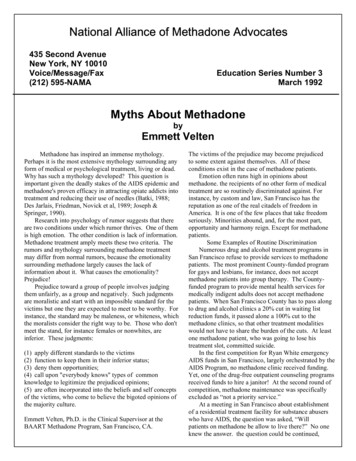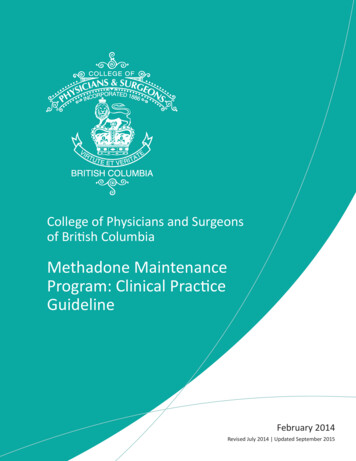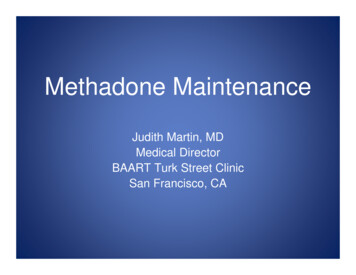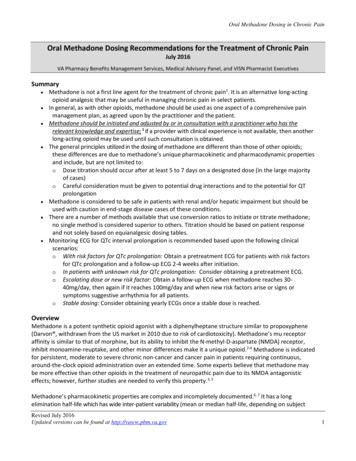
Transcription
National Alliance of Methadone Advocates435 Second AvenueNew York, NY 10010Voice/Message/Fax(212) 595-NAMAEducation Series Number 3March 1992Myths About MethadonebyEmmett VeltenMethadone has inspired an immense mythology.Perhaps it is the most extensive mythology surrounding anyform of medical or psychological treatment, living or dead.Why has such a mythology developed? This question isimportant given the deadly stakes of the AIDS epidemic andmethadone's proven efficacy in attracting opiate addicts intotreatment and reducing their use of needles (Batki, 1988;Des Jarlais, Friedman, Novick et al, 1989; Joseph &Springer, 1990).Research into psychology of rumor suggests that thereare two conditions under which rumor thrives. One of themis high emotion. The other condition is lack of information.Methadone treatment amply meets these two criteria. Therumors and mythology surrounding methadone treatmentmay differ from normal rumors, because the emotionalitysurrounding methadone largely causes the lack ofinformation about it. What causes the emotionality?Prejudice!Prejudice toward a group of people involves judgingthem unfairly, as a group and negatively. Such judgmentsare moralistic and start with an impossible standard for thevictims but one they are expected to meet to be worthy. Forinstance, the standard may be maleness, or whiteness, whichthe moralists consider the right way to be. Those who don'tmeet the stand, for instance females or nonwhites, areinferior. These judgments:(1) apply different standards to the victims(2) function to keep them in their inferior status;(3) deny them opportunities;(4) call upon "everybody knows" types of commonknowledge to legitimize the prejudiced opinions;(5) are often incorporated into the beliefs and self conceptsof the victims, who come to believe the bigoted opinions ofthe majority culture.Emmett Velten, Ph.D. is the Clinical Supervisor at theBAART Methadone Program, San Francisco, CA.The victims of the prejudice may become prejudicedto some extent against themselves. All of theseconditions exist in the case of methadone patients.Emotion often runs high in opinions aboutmethadone. the recipients of no other form of medicaltreatment are so routinely discriminated against. Forinstance, by custom and law, San Francisco has thereputation as one of the real citadels of freedom inAmerica. It is one of the few places that take freedomseriously. Minorities abound, and, for the most part,opportunity and harmony reign. Except for methadonepatients.Some Examples of Routine DiscriminationNumerous drug and alcohol treatment programs inSan Francisco refuse to provide services to methadonepatients. The most prominent County-funded programfor gays and lesbians, for instance, does not acceptmethadone patients into group therapy. The Countyfunded program to provide mental health services formedically indigent adults does not accept methadonepatients. When San Francisco County has to pass alongto drug and alcohol clinics a 20% cut in waiting listreduction funds, it passed alone a 100% cut to themethadone clinics, so that other treatment modalitieswould not have to share the burden of the cuts. At leastone methadone patient, who was going to lose histreatment slot, committed suicide.In the first competition for Ryan White emergencyAIDS funds in San Francisco, largely orchestrated by theAIDS Program, no methadone clinic received funding.Yet, one of the drug-free outpatient counseling programsreceived funds to hire a janitor! At the second round ofcompetition, methadone maintenance was specificallyexcluded as “not a priority service.”At a meeting in San Francisco about establishmentof a residential treatment facility for substance abuserswho have AIDS, the question was asked, “Willpatients on methadone be allow to live there?” No oneknew the answer. the question could be continued,
“Or will they be forced to die on the streets because ofthe prejudice against methadone and against peoplewho are on methadone?”Not just in substance abuse, mental health, andAIDS services do methadone patients face routinediscrimination. San Francisco MUNI will not allowmethadone patients to drive its buses, even though animportant legal ruling in New York overturned a similarpolicy (Beazer vs New York City Transit Authority,1975).Not just in those instances but in many otherinstances, there is discrimination against methadonepatients. Providers of methadone-related treatmentroutinely ask whether their patients might be allowaccess to various services.The prejudice stems from many sources. First, themethadone patient is still considered an addict. After all,they are still physically dependent upon a substance. Itdoes not matter to morally righteous people that themethadone patient no longer feels like or behaves like anaddict. It certainly does not matter to them thatmethadone may have saved the person’s life and savedsociety thousands of dollars. The moralists viewmethadone patients as morally weak, morally inferior.The substance abuse treatment subculture itself, andespecially the 12-step approach, is probably the mainsource of prejudice against methadone patients. the 12step program began as a voluntary and anonymousassociation of people trying to help themselves. It hasbecome a massive moral crusade, unhesitatinglyimposing its will on all others, and has almostcompletely cast anonymity aside. With God and theHigher Power on its side, it has no doubt about itsrighteous belief in the absolute necessity for abstinenceand the moral superiority of abstinent people over allothers.The 12-step “abstinence uber alles” ideology is notprevalent that most people don’t question its claims atall. Throughout drug and alcohol treatment programs, itis taken for granted that the 12-step program no onlyworks, but works better than anything else. Yet, there isno proof of that in the literature. If there were such astudy, it would be the most widely cited study in drugand alcohol literature. Twelve-step programs might beuseful, or might not, or they might be useful for somepeople with some problems.The point is that almost everyone automaticallyassumes 12-step programs “must” work because, theyare seen as the morally superior way. Hardly anyoneeven thinks proof is necessary for the 12 steps. Fewphysicians would prescribe a medication based ontestimonial support, but most of them unhesitatingly doso in the psychosocial treatment they prescribe.Many of the myths about methadone, and must ofthe rampant misinformation about it are really based onthe belief that people “on” substances are morallyinferior. In fact, this position - the “moral weakness” vsdisease model viewpoint - is what AA battled againstdecades ago. How ironic that the 12-step andcodependency treatment subculture is at the core of thebigotry against methadone patients.A Little HistoryTwo New York physicians, Vincent Dole, ametabolic specialist, and his colleague, MarieNyswander, a psychiatrist, invented methadonemaintenance. They considered heroin addiction largelya metabolic defect or deficit or disorder. In other words,they believed that people who tended to become heroinaddicts were different biologically from other people andthat this biological difference largely contributed to theirseeking heroin. Dole and Nyswander discovered, quiteby chance, that methadone was good at correcting for thedeficit, particularly so since methadone was so longacting.As a metabolic specialist Dole had studied obesityfor many years. Today’s theory that obesity can beattributed to a biological origin and not a “weakness ofwill” partly stems from his work. Dole observed that hisobese patients’ craving for food and relapse toovereating was “as if” they were addicted. He decidedto look at heroin addiction to see if there weresimilarities between his obese patients and addicts.So, initially, Dole and Nyswander were not trying tosolve the American heroin problem. The study they hadundertaken was to follow the metabolic pathways ofmorphine because they hypothesized that heroin addictsmetabolized opiates differently from normal people.Two addicts were admitted to the morphine study. Firstthey were given morphine and allowed to increase it asthey pleased. Within three weeks the subjects werereceiving eight injections totaling 600 mgs a day. Theycooperated honestly with the barrage of tests to whichthey were subjected. But, much of their time was spentin front of the television set waiting for the nextinjection.By law Dole had to detox his two subjects when theexperiment was completed. He switched them tomethadone, the approved form of treatment fordetoxification. However, instead of reducing themethadone, Dole and Nyswander decided to run thesame tests as they had on morphine. This way theycould compare morphine to methadone.Now something unusual began to happen. The oldersubject began to paint and the younger began requestingto go back to finish high school. The two subjectscontinued to take their methadone daily. Their behaviortransformed for the better. They went from the street tostable living and better housing, from the jailhouse to theschool house, from sickness unto health.These facts were important, of course, to Dole andNyswander, but were completely crucial in their long
battle to get government to go along with the idea ofmethadone maintenance. Government reflectsAmerican’s practical tendency as well as its moralistic,judgmental tendency, and in this case the practicaltendency can out on top. Government allowed itself tocare about the fact that methadone patients are far more“cost effective” for society than are heroin addicts.There was an intention to cut costs, reduce crime, maybeto help people. Methadone maintenance had beensurprisingly effective in doing those things. But themain point in Dole and Nyswander’s thinking alwaysappeared to be that heroin addiction is a medical disorderand that methadone is a use supplement to a biologicaldeficiency (Dole & Nyswander, 1967; Dole &Nyswander, 1965; Dole, Nyswander & Kreek, 1966).In reality, methadone treatment is barely tolerated bygovernment. The main reason being that in out societypeople who are “on drugs” are considered morallyinferior to others. Due to the AIDS epidemic methadonetreatment has been given a temporary bit of breathingspace. Still it is difficult to gain access to methadonemaintenance. Staying in treatment is much, much harderthan getting into treatment. The regulations andrestrictions relating to methadone maintenance are sonumerous that it is amazing that anyone can make itwork.Myth #1DOLOPHINE WAS NAMEDAFTER ADOLF HITLERDolophine is the name under which Eli LillyCompany markets methadone. When methadone wasfirst used for maintenance treatment of heroin addiction,Dolophine was the common brand name of methadone.It was dispensed as a wafer. Certain problems becameapparent in the use of the wafers. It is quite difficult todispense small increases or decreases in milligrams ofmethadone.For this and other reasons, when methadone becameavailable in a stable liquid suspension (Methadose), mostclinics dropped Dolophine and went to it. Dolophine ispractically history now. Some younger methadonepatients and staff may have never heard of it, much lessthe myth about its having been named for Adolf Hitler.The connection, by the way, is that the “Dolph-” ofDolophine is supposed to be the “dolf” of Adolf.A minor myth about methadone is that Methadose isnot real methadone. All methadone is the samechemical. Methadose is just a brand name. 1The Germans invested in methadone during thesecond world war when their supplies of opium were cutoff. 2 During war the Germans of course needed morepainkillers than usual, so they got to work synthesizingopioids. Meperidine, its brand name is Demerol, wasanother analgesic they invented, along with severalhundred others that didn’t become famous. You’llnotice that there are no myths about Demerol’s havingbeen named for Nazis. The reason methadone‘unlucked-out’ has to do with the fact that methadonedid emerge as a maintenance treatment for heroinaddicts.In short, the myth is that since Adolf was a badperson who wanted to control people and was againstfreedom of choice, “they” gave his name to a bad drugused to control people.The myth is colorful and just happens to tie in withthe prejudice against methadone, but what is the truthabout Dolophine? In Latin dolor means pain, suffering.In English (look it up in an unabridged dictionary) thedol means “a unit in pain measurement” and there aresuch words as dolorimetry. The dol in Dolophine wasfrom dol, dolor (Goldstein, 1992).The “-phine” in Dolophine comes from morphine,which was from Morphin, which was its Germantrademark name from the early 1800’s. Morphin camefrom Morpheus, the god of dreams of mythology, whowas a son of Hypnos, who later begat hypnosis.The Germans also invented heroin, which Englishword came from the German trademark, Heroisch, fromtheir word meaning heroic. The German pharmaceuticalcompany that manufactured heroin was named “Bayer”of aspirin fame.Heroin’s chemical name is diacetylmorphine,sometimes shortened to diamorphine. After morphineand heroin, and before methadone and Meperidine(Demerol), the Germans also invested the all-timepainkiller, which we still know by the Germantrademark name, Aspirin!Myth #2METHADONE IS ADDICTINGIt is not substances which addict, it is people whoaddict themselves to various feelings and experiences.Some of these feelings and experiences are producedby substances.1. Methadone is not a brand name, it is the generic.This is another myth that many respectedprofessionals have believed.2. Methadone was synthesized by Max Bockmühl andGustav Ehrhart at I.G. Farbenindustrie. They namedit Hoechst 10820 or polamidon. Basically they weresearching for an analgesic with a low addictionproperties. The patent for methadone was not appliedfor until 1941 and only reasech was undertakenduring this period until World War 2 was over. Afterthe war the US controlled Hoechst the town whereI.G. Farbenindustrie was located. Since the US tookcontrol of any German patents methadone became aspoil of the war along with many other substances.(See Methadone and Congeners in Education Series5.2, The Pharmacology of Opioids, BasicPharmacology: How Methadone Works?)
The belief that substances addict people is driven bythe fact that few people have any real idea ofresponsibility without considering it to be equivalent toblame. The whole disease theory’s main attraction isthat it gets people off the hook. If their disease makethem behave poorly, then they are not to blame.However, this belief leaves them powerless. Such abelief probably also helps increase the level and numberof addictions in our culture.An alternative conception is that people areresponsible for their behavior themselves, but that theirbest chance for their behavior themselves, but that theirbest change comes from accepting responsibility. Manypeople addict themselves to relationships (AKA “love”),gambling, and shopping, and a few people in modernAmerica are addicted to work. With these and variousother addictions there is no physical substance.Substances are not addicting; some of them create aphysical dependency, which means that there arewithdrawal symptoms when the substance is withdrawn.If substances “caused” addiction, then all the servicepeople who became heroin addicts in Vietnam wouldhave lived out their lives upon returning to America asheroin addicts. The fact is that most of them stoppedusing heroin when they left Vietnam and never used itagain. 3If “addicting” substances caused addiction, then allthe complicated surgical patients who have to bemaintained for prolonged periods on morphine would goon to be addicts. Practically none of them does,however. When they are withdrawn from the morphine,they feel crummy. In time the crummy feelings goaway, and that’s it.Addiction is a mental state, a though process, apurpose. The addiction is the meaning of the feelingsand experiences to us; it is our decisions to seek thefeelings and experiences with less and less regard foroverall consequences; it is the rationalizations we makeup about how it’s okay to keep doing what we’re doing,and, sometimes, how we aren’t even doing what we aredoing!Methadone patients may be maintained onmethadone for years, using no heroin at all. Some ofthese patients, upon departing from methadonetreatment, eventually relapse into drug use. What dothey use? Heroin, almost every time; certainly not streetmethadone. They had been physically dependent uponthe methadone for years, but the addiction is to theheroin. This is because the feelings produced by heroinare judged much better by most heroin addicts than thefeelings produced by methadone.3. Since the original study undertaken by D. Huntthere have been discrepancies found in the followup methods. Many scientists now refute thefindings of these studies.Myth #3METHADONE IS HARDER TOGET OFF THAN HEROINThe heart of this myth is myth #2, namely thatsubstances addict people. Instead, people addictthemselves to various feelings and experiences, orhighs, some of which may be related to substances,some not. Different people like different highs todiffering degrees. The quality of the high influencesthe likelihood that various people will tend to seek itout. To day that a certain substance is powerfullyaddicting means mainly, “Because I like the high itgives me, I continue to choose to use it, come hell orhigh water, and I won’t tolerate the prospect of nothaving it.”In studies of physical withdrawal sings fromheroin and methadone, where the amounts of the twodrugs are pharmacologically equivalent, withdrawalfrom methadone is slower and longer. None of that hasanything to do with heroin or methadone “addicting”people, however. Neither one of the addicts people.We addict ourselves to various feelings andexperiences. Most methadone patients report that thefeeling it gives are pretty piddling compared to thefeelings produced by heroin.Much of the addictive attraction of any drugdepends on the rapidity and duration of its action.Methadone is administered orally, gets into the systemslowly compared to injected heroin, and is very, verylong-acting. However, in studies with seasoned opiateaddicts where injected drugs were compared, theycould not immediately distinguish heroin frommorphine from methadone. Seasoned stimulant users,similarly cannot distinguish dextroamphetamine fromcocaine from methylphenidate (Ritalin) immediatelyupon injection. Cocaine has a greater addictiveattraction (for most people) than does amphetamine,however, because of the former’s much shorterduration of action.Myth #4PEOPLE GET ON METHADONEJUST FOR THE HIGHMost people get on methadone because they areexhausted, fed up, desperate, can’t keep a heroinaddiction going and can’t keep themselves togetheranymore. In short, they have to get on methadone.Addicts do not have to be forced to seek a high. Take alook at the people in dosing lines at methadone clinics.You won’t find many who look high. They look likeanyone else who has to wait in long lines in unpleasantsurroundings.Most heroin addicts will tell you the high behindmethadone is quite inadequate, at least in comparisonwith “the real thing.” You may have heard a saying, “If
God made something better than heroin, He is keeping itto Himself!”Almost all opiate addicts like heroin better thanmethadone. The most seasoned staff people at methadoneclinics have seen thousands of intake urinalysis results.Only a very small percentage of those results have anymethadone in them (usually with morphine/codeine[heroin]). Only a tiny percentage have only methadone.Very, very few street addicts have methadone as their drugof choice.Some recovering addicts in drug-free treatmentprograms, and especially some of their staff members,may wishfully (and jealously) think that methadone is awonderful high. This is the stuff of their troubled dreams,but reality is another matter.Myth #5ONCE ON METHADONE,YOU CAN’T GET OFFThis is a complex myth and would better beexamined at several levels. At a purely literal level,obviously there are methadone patients who leavemethadone programs. This happens all the time. So itis not true “that you can’t get off methadone.”At another level this myth refers somewhat to the socalled “revolving door” of street addiction andmethadone maintenance (or other forms of treatment).Addiction is a long-lasting metabolic disorder withroots deep in human nature, personality, family,upbringing, social environment and cultural values, andit is true that it can take a long time before any particularaddict decides to change, changes, and stays changed.Methadone treatment, when followed by lapses andrelapses, may seem to some people to be the cause of therelapse. This is the logical error, “Post hoc, ergo propterhoc.” (After this, therefore because of this.)To some extent this myth blames the methadone forthe fact that someone is on methadone, and onetranslation would be, “If it weren’t for the methadone, Iwouldn’t be an addict!”Thus, this myth is a cop-out. Most of use are proneto think that some thing outside ourselves is responsiblefor our undesirable behavior (but much less prone tolook to the outside in explaining our desirable behavior!)This cop-out relieves us of the responsibility for puttingout effort to change and it gives us something to blamefor failure if and when we do try to change. Of course, italso help ensure that we will keep out problems.This myth is a variation of another popular myth,“Once a junkie, always a junkie.” Untrue. Most longterm methadone clinic staff members know a number offormer heroin addicts and methadone patients who areno longer addicted. Obviously there are many people inNA, Rational Recovery, Women For Sobriety, andSecular Organizations for Sobriety who are no longerpracticing addicts. People change themselves, sometimeswith treatment, sometimes without. No one is born witha needle in the arm, and no one has to die with one there.The DARP (Drug Abuse Reporting Program) studyfound that a substantial percentage of methadonepatients has not used illicit drugs at two-year follow-up(Sells, 1974a. Sells, 1974b; Sells & Simpson, 1976a;Sells & Simpson, 1976b; Sells & Simpson, 1976c).Therapeutic community graduates were equallysuccessful. Drug-free outpatient graduates wereconsiderably less successful. It’s really time to lot go ofany delusions to the effect that drug free outpatientcounseling is worth recommending for treatment ofopiate addicts. Generally speaking, it isn’t.The unstated continuation of this myth is “withoutdiscomfort. Magically.” Low frustration tolerance, withits associated over rebelliousness and lack of willingnessto work hard to over come problems, contributessubstantially to why most people keep their problems,including addictions. Most of us don’t want to believethat our lack of persistence contributes to our keepingcertain problems, so we perfume this by saying, “Youcan’t get off methadone,” or, “Once on methadone,‘they’ keep you on it.”Myth #6METHADONE PROLONGSAN ADDICT’S CAREER IN DRUGSThe DARP research, which began in the early 70sfor about a hundred drug abuse treatment programs thatreceived federal funds, and originally involved about45,000 subjects, had recently had its twelve yearfollow-up. What has been found over the years in theanalysis of the data is that demographic variables andvarious personal characteristics of patients seem to bethe main predictors of longevity of drug career. Thesefactors have been found across the three treatmentmodalities that were in the study: methadonemaintenance, therapeutic communities, and drug-freeoutpatient counseling.Some findings in the research are as follows: Theyounger some began drug use, the longer the career.The less education, the longer the career. The moretimes stopped by the police but not arrested, the longerthe career. The number of times the addict movedgeographically to avoid the police, the longer thecareer. Addicts employed in square, higher status jobstended to have longer drug careers than street addicts.(However, it was found that the square, higher statusjob holders had considerable better courses of treatmentand treatment outcomes than did the street addicts oncethey did get into treatment. So much for the concept ofhitting the bottom! Those people did not hit thebottom.)Thus, length of drug career does not appear relatedvery closely to any form of treatment in itself. Itappears related to a variety of other factors.
Myth #7METHADONE DOES NO GOODA former methadone patient, now a successfulmother and pre-med student with several clean and soberyears, was asked to comment on the idea that methadonedoes no good. 4 She had been on methadone severaltimes. “The only thing being on methadone the firsttime did for me,” she said, “was save my life.”Exposure to diseases, attack on the street, overdose,and so forth are all reduced substantially for mostpatients on methadone. They have a better chance tostay alive. In their pursuit of the wickedness of being“on” something, some critics of methadone seem toforget the human angle. The death rate, arrest rate,illness rate of addicts drops substantially when theyenroll in methadone treatment. Their legitimateemployment rate, the taxes they pay, and their immunesystem functioning, all rise. These factors are importantand would be important even if methadone treatmentwere less effective than outpatient drug-free treatment,but such is not the case.In the second edition of his monumental text onheroin addiction, Jerome Platt said,“Based on predictors of outcome using amultiple discriminant analysis approach,outcomes for methadone maintenanceand treatment communities exceededexpectation, the drug free programs didmore poorly than expected.”Sells, the chief DARP researcher concluded thatmethadone maintenance as well as therapeuticcommunity approaches have demonstrated their worthfor narcotics treatment, while outpatient drug-freeprograms are seen as mainly useful for youthfulnonopioid and polydrug users (Sells & Simpson 1980).Myth #8METHADONE CAUSES PATIENTSTO TURN TO ALCOHOLThe idea in this myth is that there is a special tendencyfor methadone patients to turn to alcohol because they areon methadone. The DARP studies indicated that theamounts of alcohol consumed by methadone maintenancepatients and therapeutic community and outpatient drugfree clients at the beginning of treatment were almostidentical. At earlier follow-ups after treatment, theamounts of alcohol reported consumed has increased4. The use of clean is no longer acceptable andanother example of the use of stigmatizinglanguage. A diabetic that followed medicalprescriptions is not referred to as clean. And thistype of language infers that individuals displayingsymptoms of addiction are “dirty”.considerably. These increases were almost identical foreach of the three treatment modalities. Therefore, it can beconcluded that methadone treatment has no specialrelationship to people’s propensity to increase their alcoholintake.At 12-year follow-up, it was concluded that theincreases in alcohol consumption reported above hadleveled off within a few years of completion of treatment.It has been found in the DARP follow-ups, including the12-year follow-up, that as time passes a larger and largerpercentage of the original subject group remained free ofillicit drug use. Therefore, it appears that there is noprogressive tendency to substitute alcohol for heroin.some, but only some, patients may so substitute, or at anyrate increase alcohol consumption.Myth #9METHADONE HURTS YOUR HEALTHThere have been well over 2,000,000 patient yearson methadone, and thousands of babies have been bornto mothers on methadone. The health status of patientson methadone has probably been studied with greaterfrequency and depth than that of any other medication.Mary Jeanne Kreek, M.D. Senior Research Associateand Physician, Department of biology of AddictiveDisease of The Rockefeller University, concluded asfollows in her encyclopedic review of the literature(Kreek, 1983).“The most important medical consequence ofchronic methadone treatment, in fact, is the markedimprovement in general health and nutritionalstatus observed in patients as compared with theirstatus at time of admission to treatment. Mostmedical complications observed in methadonemaintenance patients are either related to ongoingpreexisting chronic disease, especially chronic liverdisease, the onset of which occurred prior to entryinto methadone treatment, or to coexisting newdiseases or illnesses or to ongoing polydrug oralcohol use. Clearly the most common cause ofserious medical complications in methadonemaintained patients both during the methadonemaintenance treatment and also during andfollowing withdrawal is chronic alcohol abuse.”
ReferencesBatki, S.L. Treatment of intravenous drug userswith AIDS: The role of methadone maintenance.Journal of Psychoactive Drugs 1988 20: 213216.Legal Action Center. Beazer vs New York CityTransit Authority: A Landmark Decision onMethadone Maintenance [Report]. New York:National Institute on Drug Abuse, 1975.Des Jarlais, D.C.; Friedman, S.R.; Novick, D.M.et al. HIV-1 infection among intravenous drugusers in Manhattan. Journal of the AmericanMedical Association 1989 261: 1008-1012.Dole, V.P.; Nyswander, M.E. Heroin addiction:Metabolic disease. Archives of InternalMedicine 1967 120: 19-24.Dole, V.P.; Nyswander, M.E. A medicaltreatment for diacetylmorphine (heroin)addiction. Journal of the American MedicalAssociation 1965 (August 23) 193(8): 646-650.Dole, V.P.; Nyswander, M.E.; Kreek, M.J.Narcotic blockade. Archives of InternalMedicine 1966 (October) 118:304-309.Goldstein, D. Personal communication, Eli LillyPharmaceuticals, 1992.Joseph, H; Springer, E. Methadone maintenancetreatment and the AIDS epidemic. In: TheEffectiveness of Drug Ab
AIDS Program, no methadone clinic received funding. Yet, one of the drug-free outpatient counseling programs received funds to hire a janitor! At the second round of competition, methadone maintenance was specifically excluded as "not a priority service." At a meeting in San Francisco about establishment










